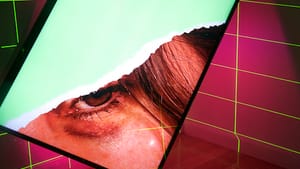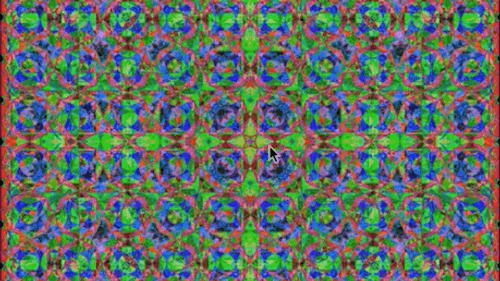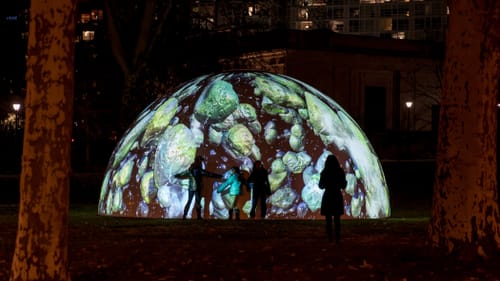Stay in the Loop
BSR publishes on a weekly schedule, with an email newsletter every Wednesday and Thursday morning. There’s no paywall, and subscribing is always free.
The digital underground is ready for its closeup
Cashing in on "new media" art

Let’s be honest, Philadelphia is known for old things. We are the city of firsts, the birthplace of the nation. But has this association with the old hindered our ability to embrace new forms of artistic expression? New technologies are fast becoming the creative media of the 21st century, yet they still haven’t been fully embraced by traditional institutions or galleries here.
One problem is that many exhibition spaces find it difficult to show and monetize some of the categories of work that fall under the "new media" umbrella: Internet art, bioart, interactive art, and virtual art. The nature of the genre requires a unique sales structure and evolution of the existing means of commodification. But local artists, curators, and advocates are starting to confront the struggles that face new media art in Philadelphia.
Sharing the wealth
You're less likely to see this type of work in commercial galleries. Instead, look to artist-run and progressive spaces. FringeArts, for example, launched Digital Fringe in 2015. This program mobilizes new media creators, connecting them to audiences, communities, and experiences.
Hallie Martenson, FringeArts’ marketing and communications director, explains, “We recognized that traditional art forms were going more digital, and digital art practices were becoming more popular. Because these pieces of art exist on a free platform, they are a distillation of what the fringe movement is about: democratization of and access to the arts.”
FringeArts might want to offer free access to digital art, but Andrew Cameron Zahn, new media artist and director of CRUXspace, an art gallery “dedicated to technological art and design,” wants to elevate both its stature and its prices. “Our plan is to sell prints, art books, and artists’ books via our own online gallery. These will be items produced with CRUXspace and exclusive pieces we help artists generate from their work, as well as original pieces.”

CRUXspace is the first and only space in Philadelphia exclusively showing new media work. The gallery closed in 2016 but is relocating to WeWork Northern Liberties, a coworking community in the Piazza at Schmidt’s.
Other galleries, such as Fabric Workshop and Museum, Vox Populi, and Crane Arts, have also featured new media work. But the single-minded growth of a gallery like CRUXspace demonstrates a greater need for exhibition space for local artists working in these mediums.
Intangible value
Galleries assisting new media artists to produce salable items — when the work itself is neither replicable nor tangible — are rare. More artists are assuming and assigning value to their work outside of galleries and institutions.
Chicago-based new media artist Shawné Michaelain Holloway uses collage and mixed media to translate her Internet-based works into material for showing. Other new media artists, such as New-York-based Rafael Rozendaal, “a visual artist who uses the Internet as his canvas,” created a system of patronage modified for the medium. His works are accessed by a single URL connected to an animated piece. After purchase, collectors receive rights and access — source code, offline exhibition files, the ability to exhibit and sell the work, and the site domain name — while the piece remains publicly accessible.
When galleries and institutions lagged in adjusting for the influx of new media art, the responsibility for assigning economic value to that work shifted directly to artists. Echoing FringeArts' Martenson, local multidisciplinary artist Eva Wǒ says, “I rarely see new media work in traditional galleries and arts institutions, perhaps because new media is a nontraditional contemporary medium influenced by the perceived accessibility and even playing field of the Internet.”

Wǒ’s work in the medium of “NSFW” (not safe for work) GIFs explores the Internet and how tangibility and intangibility affect the way one thinks, behaves, and is seen. “As a millennial, I am exposed to a lot of different ideas and art through the Internet every day, which may be surpassing galleries and institutions as the most relevant source of exposure.”
Taking it to the streets
Angela McQuillan, artist and current curator of University City’s Esther Klein Gallery, has been one of the few local galleries to show BioArt. “When it comes to something like BioArt, or art that uses biotechnology or biological media,” she says, “Philadelphia's galleries have not embraced this type of work much, if at all.”
Again, money may be the issue. She explains, “Most of the bioartists and new media artists I have worked with make their income as a professor and receive supplemental grants and funding to make their artwork. It seems difficult to monetize this type of artwork in a gallery setting as a sole source of income. I have never personally sold a piece of new media work in my gallery or even had any sales inquiries.”
Despite the difficulties of selling and showing new media art in Philadelphia, Jennifer Steinkamp's "Winter Fountains” (which currently illuminate the Benjamin Franklin Parkway), Comcast’s “Holiday Spectacular,” and City Hall’s holiday light display increase the form’s public visibility. However, until artists and exhibitors find the secret to making the work pay, it might be a while before we can truly declare digital arts the “media of our time.”
Sign up for our newsletter
All of the week's new articles, all in one place. Sign up for the free weekly BSR newsletters, and don't miss a conversation.
 Amanda V. Wagner
Amanda V. Wagner